








MIDWEEK UPDATE 30 JANUARY 2019Plan Your Weekend……..Forthcoming Events…….Aviation News Worldwide Incidents and Accidents……This Week in Aviation History  2: SAAF Museum AFB Zwartkop open practise day. Officer Commanding Museum oc@saafmuseum.org.za 012 351 2290 2: SAPFA Morningstar Speed Rally - Morningstar Airfield. Contact Hans Potgieter e-mail: hcom@mweb.co.za    9: Rand Model Aeronautical Club Pylon Racing. Corner of Swartkoppies road & Klipriver Drive, Johannesburg South. Contact allsopp.elaine@gmail.com 9: Rustenburg Breakfast Fly-in. Contact Mauritz Muller mauritzmuller1@gmail.com 3rd Saturday of every month. Microland. Bring and braai. Fires and bykos provided. Fires start from 09h30. Contact person: Nick Swardt 082 441 8011 or Alan Hussey 072 82 2341   1-3: Henley RC Fly In. Meyerton, Gauteng. 2: SAAF Museum AFB Zwartkop open practise day. Officer Commanding Museum oc@saafmuseum.org.za 012 351 2290 4-7: HAI Heli-Expo. Georgia World Congress Centre, Atlanta, Georgia. Contact E-mail: rotor@rotor.org Website: www.rotor.org 6: EAA Chapter 322 meeting. Dicky Fritz Moth Hall Edenvale. Contact: kevinmarsden88@gmail.com 9 & 10: Swellendam Flying Club Sport Aerobatic Club Regional Championships Contact Pieter Venter e-mail: pventer@vgv.co.za 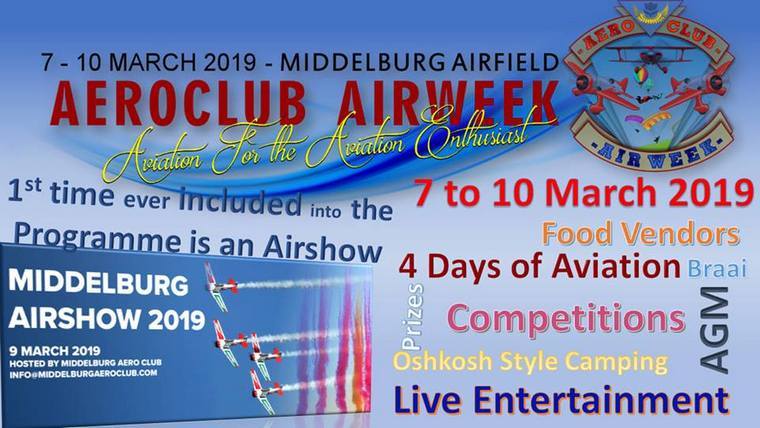 8-11: Aero Club Air Week at Middelburg. Contact Alan Evens Hanes 011 802 1100 E-mail alan@aeroclub.org.za 9: Aero Club Airweek Speed Rally planned Saturday 9th March. Contact Rob Jonkers e-mail: rob@aerosud.co.za cell: 082 804 7032 9: Middelburg Aero Club Airshow. info@middelburgaeroclub.com 9: Aero Club AGM. Middelburg. Contact Sandra Sandra@aeroclub.org.za 12-14 March: Saudi Airshow Thumah Airport, Riyadh. Website: www.saudiairshow.aero 13-15: Ageing Aircraft & Aircraft Corrosion seminar at OR Tambo International Airport. Contact e-mail: lmjaviationbookings@gmail.com 23: FASHKOSK at Stellenbosch airfield. Contact Anton Theart Cell: 079 873 4567 E-mail: gm@stelfly.co.za 3rd Saturday of every month. Microland. Bring and braai. Fires and bykos provided. Fires start from 09h30. Contact person: Nick Swardt 082 441 8011 or Alan Hussey 072 82 2341 23: SAPFA Virginia Fun Rally - Virginia Airport. Contact Mary de Klerk cell: 084 880 9000 e-mail: maryd@expandingbranding.co.za   4-6: SAPFA Rally Nationals & Fun Rally - Stellenbosch Airfield. Contact Frank Eckard cell: 083 269 1516 e-mail: frank.eckard@mweb.co.za 6: Robertson Annual Breakfast fly in. Contact Alwyn du Plessis cell: 083 270 5888 e-mail: boeredata@breede.co.za 6: Coves Airfield Hartebeespoort Fly-in. Contact JP Fourie, jp.fourie@nac.co.za 083-625-4804 or Thys Kuhn, thys.kuhn@gmail.com 082-568-5614 or Jan Hanekom, jan@tilt-tech.co.za 083-279-6572. Please note than all participants need to collect indemnity & information packs from any of the contact personnel. All Fixed Wing and Helicopters are welcome. 13: Uitenhage Festival. Contact Lourens Kruger e-mail: lmk@telkomsa.net cell: 082 320 2615 4-14: Stars of Sandstone Ficksburg, Eastern Free State. Contact www.starsofsandstone.com 10-13 April: AERO Friedrichshafen, Germany Global show for General Aviation. Contact Stephan E-mail: stephan.fischer@messe-fn.de 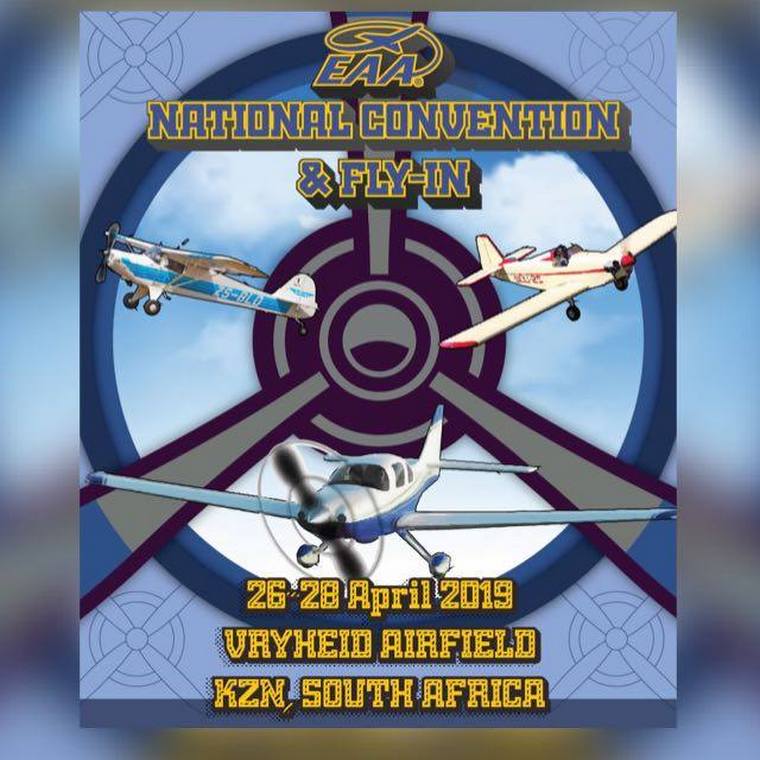 26-28: EAA National Convention Vryheid KZN. Contact Marie Reddy 083 259 7691 27: SAPFA EAA Convention Adventure Rally - Vryheid. Contact Rob Jonkers cell: 082 804 7032 e-mail: rob@aerosud.co.za 27 & 28: SAC Judges Trophy venue TBA. Contact Annie Boon e-mail: chunge@mweb.co.za  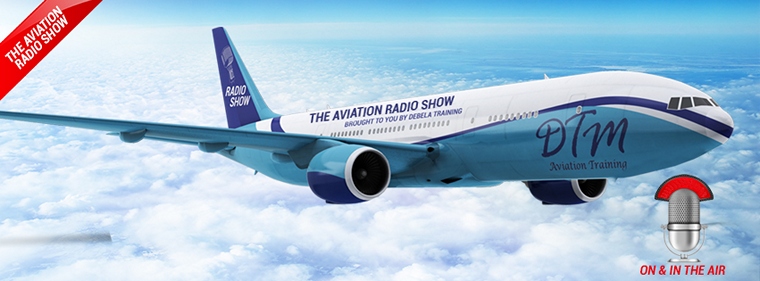 The Aviation Radio Show; get all your questions answered in one place. To listen to a recording of the live broadcast click on the link: www.debela.co.za/aviation-radio-show  TWO DAHER TBM VERY FAST TURBOPROP AIRCRAFT MAKE MILESTONE FLIGHTS OVER THE SOUTH POLE 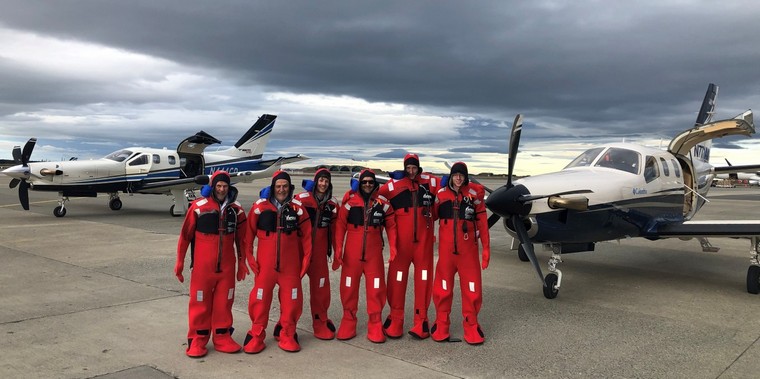 Daher salutes the exceptional flights performed this month by owner-pilots on two TBM aircraft that traversed Antarctica and overflew the magnetic South Pole. The TBMs crew in survival suits before their departure from SCRM Chilean Antarctica airport. Photo © Daher TBM One of the TBM owner-pilots - Sebastian Diaz from Santiago, Chile - reunited three generations of pilots in flying his TBM 850 with Diaz' father, 88-year-old Patricio (one of the oldest still fully-licensed TBM pilots); and Sebastian's son, Sebastian Jr., as copilots. The other TBM owner-pilot, Dierk Reuter from Chicago, USA, was flying with son Alex on his TBM 930, carrying cameras and an inflight tracking system benefitting from an Iridium GO! satellite connectivity device and support of Iridium Communications. In-flight photos were posted to Instagram in quasi real-time using Iridium messaging and software created by the Reuters. The 2,700 nautical mile trip for both aircraft from Santiago, Chile, to 75° South - the latitude required for the polar circumnavigator diploma - required three stopovers and much preparation, as Antarctica offers some of the most challenging environments for aviators. The temperature averages -56°F (-49°C) with constant winds. Both TBMs had to fly over the huge continent - nearly 5 million square miles (12.9 million square kilometres) in size, largely uninhabited and mostly covered in ice. In addition, central Antarctica presents high ground that rises to more than 8,000 feet (2,500 meters), with mountain peaks reaching 16,050 feet (4,892 meters) - where clear blue skies can quickly turn to overcast whiteout conditions. On January 1, the two TBM aircraft left Punta Arenas in Chile: destination Teniente Rodolfo Marsh Martin Airport on King George Island (part of Chile's Antárctica commune in Antarctica, and the continent's northernmost airport). This airport serves the nearby village of Villa Las Estrellas and Base Presidente Eduardo Frei Montalva - the most important Antarctic base of Chile - with a 4,232-foot (1,290-meter) gravel runway. On January 2, both TBMs continued to the British Antarctic Survey Sky-Blu base, at 807 nautical miles southwest, and reached the 75° South latitude turning point before returning to King George Island's airport. On the way, TBM 930 owner Jim Baum arranged a fly-by of the National Geographic Orion - an ice-class exploration ship, enabling exciting pictures and video to be recorded. Dierk Reuter explained: "The journey from my hometown Chicago to 75S 71W and back can be summarized in figures: 18,782 nautical miles, 64 hours, 3,080 gallons of jet fuel, and 19 stopovers. But it doesn't tell the story about a pilot's feeling to fly over the South Pole. The TBM is an awesome aircraft to explore the globe!" Added Sebastian Diaz: "We also had the challenge of avoiding the freezing of the fuel because of the extreme low temperatures, for which we used more Prist [fuel system icing inhibitor] than usual. We also like to thank the Chilean Air Force for their generous hospitality at SCRM (Base Presidente Eduardo Frei Montalva)." The TBM 910 and TBM 930 are the latest members in Daher's TBM family of very fast single-engine turboprop aircraft. Differences between the two models are concentrated on their primary avionics: Garmin's G1000 NXi avionics system with physical keypad for the TBM 910; Garmin's G3000 with touchscreen controller for the TBM 930. To date, a total of 910 TBM aircraft have been delivered to international owners and operators, with the global fleet accumulating some 1.6 million flight hours. 265 TBM 900-series aircraft have already delivered through December 31, 2018. They are built by Daher on its industrial site at the airport of Tarbes-Lourdes-Pyrénées (Hautes Pyrénées), France.  BUILD A WATCH- AVIATION THEMED WATCHES  “Build a watch” does not necessarily mean that you are building a watch it means that you can customise a watch to your specifications. It started as an idea for a unique watch that I wanted, but it was not available to purchase. I stuck my feelers out to see what the demand was. Aviation themed watches were not easy to come by. The demand was high. I am an Avionics and instrument technician, so dismantling the watch wouldn't be that much of a challenge when it came to small parts. The watches are of top quality, yet in an affordable price range. They are water resistant, yet not water proof. You can forget to take your watch off in the shower, run in the rain, or be blonde like my wife and stick your hand in the bath, the watch will survive. Each watch comes with a 6 month warranty. We do watches with family faces, watches with avionic instruments, watches with animals. You dream it, we make it. We will design your watch for you at no extra cost, after you have chosen the watch, we send the artwork to be done. Then the magic happens. Contact Garth at garth.evens36@gmail.com or phone 074 471 8992  Boeing [NYSE: BA] yesterday successfully completed the first test flight of its autonomous passenger air vehicle (PAV) prototype in Manassas, Virginia. Boeing NeXt, which leads the company's urban air mobility efforts, utilized Boeing subsidiary Aurora Flight Sciences to design and develop the electric vertical take-off and landing (eVTOL) aircraft and will continue testing to advance the safety and reliability of on-demand autonomous air transportation. Photo © Boeing. "In one year, we have progressed from a conceptual design to a flying prototype," said Boeing Chief Technology Officer Greg Hyslop. "Boeing's expertise and innovation have been critical in developing aviation as the world's safest and most efficient form of transportation, and we will continue to lead with a safe, innovative and responsible approach to new mobility solutions." Powered by an electric propulsion system, the PAV prototype is designed for fully autonomous flight from take-off to landing, with a range of up to 50 miles (80.47 kilometres). Measuring 30 feet (9.14 meters) long and 28 feet (8.53 meters) wide, its advanced airframe integrates the propulsion and wing systems to achieve efficient hover and forward flight. "This is what revolution looks like, and it's because of autonomy," said John Langford, president and chief executive officer of Aurora Flight Sciences. "Certifiable autonomy is going to make quiet, clean and safe urban air mobility possible." The test flight represents the latest milestone for Boeing NeXt. The division works with regulatory agencies and industry partners to lead the responsible introduction of a new mobility ecosystem and ensure a future where autonomous and piloted air vehicles safely coexist. In addition to the PAV, the Boeing NeXt portfolio includes an unmanned fully electric cargo air vehicle (CAV) designed to transport up to 500 pounds (226.80 kilograms) and other urban, regional and global mobility platforms. The CAV completed its first indoor flight last year and will transition to outdoor flight testing in 2019. "Boeing was there when the aviation industry was born and in our second century, we will unlock the potential of the urban air mobility market," said Steve Nordlund, vice president and general manager of Boeing NeXt. "From building air vehicles to airspace integration, we will usher in a future of safe, low-stress mobility in cities and regions around the world."  AIRBUS HELICOPTERS SEES STRONG SALES INCREASE IN 2018 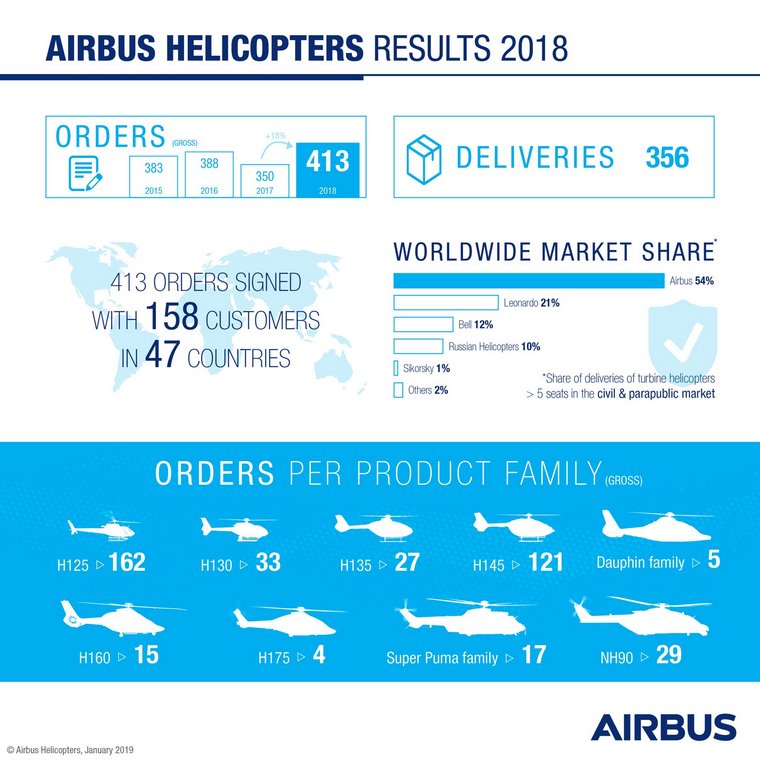 Airbus Helicopters delivered 356 rotorcraft and logged gross orders for 413 helicopters (net: 381) in 2018 (up from 350 gross orders in 2017), maintaining its lead in the civil & parapublic market while reinforcing its position in the military market thanks to key successes with international campaigns. The company also booked 148 orders for light twin-engine helicopters of the H135/H145 family and secured 15 orders for the next-generation H160. At the end of last year, the overall backlog increased to 717 helicopters. Image © Airbus "Our commercial performance in 2018 demonstrates the resilience we have developed as a company to help us navigate what remains a challenging environment," said Bruno Even, Airbus Helicopters CEO. "Even though the civil & parapublic market remains at a low level worldwide, we have managed to maintain our global leadership thanks to our wide and modern portfolio of products and services and our international footprint. Meanwhile, we have increased our market share in the military sector by securing major contracts with leading armed forces worldwide, with best-in-class solutions. These positive trends give us the means to prepare the future and continue our transformation, with innovation at our core and customer loyalty at heart." In 2018, Airbus Helicopters delivered the first of 100 H135s for China in Qingdao, where a dedicated final assembly line will serve the growing demand of the Chinese market for civil & parapublic helicopters. Meanwhile, Hong Kong Government Flying Service took delivery of the first H175s in public services configuration. Last year also proved successful for the Super Puma family which demonstrated its versatility by being selected in key military campaigns, while attracting new civil & parapublic customers with repurposed H225s previously operated on the oil & gas market. Likewise, 2018 proved to be a very positive year for the NH90, which attracted orders for 28 units in Qatar while being selected by Spain in the frame of a follow-on order for 23 units. Key programme milestones were achieved in 2018, including the power-on and ground testing of the CityAirbus electric vertical take-off and landing (eVTOL) technology demonstrator, ahead of a maiden flight expected early 2019. The first H160 in serial configuration entered flight trials in 2018, while the VSR700 unmanned aerial system demonstrator performed its first unmanned flights at the end of the year.   Eurofighter Typhoons belonging to the Austrian Armed Forces will secure the airspace on the occasion of the World Economic Forum 2019 in Davos. The World Economic Forum will be held in the Swiss mountain resort from 22 to 25 January, bringing together more than 3,000 global leaders from politics, industry and academia, including numerous Heads of State and Government. Photo © Eurofighter. Eurofighter Typhoon has rapidly accumulated hours across the fleet, particularly in recent years, following an increase in the tempo of air policing and combat operations. There is now a fleet of almost 500 aircraft protecting Europe's borders, with the potential for this number to grow substantially in the coming decades.   The Bell V-280 Valor successfully achieved its namesake optimal cruise speed of 280 knots on Wednesday, 23 January 2019 at our Flight Research Center in Arlington, TX.Building on a full year's worth of testing and more than 85 hours of flight time, Bell's V-280 Valor reached its namesake cruising speed of 280 knots true airspeed this week. Photo © Bell. It is a remarkable achievement to hit this airspeed for the V-280 Valor in just over a year of flight testing. Beyond the exemplary speed and agility of this aircraft, this significant milestone is yet another proof point that the V-280 is mature technology, and the future is now for FVL capability set 3. Purpose-built to conduct long range assault at twice the speed and range of existing medium lift helicopters, the V-280's technical maturity demonstrates that close collaboration between government and industry can deliver transformational capabilities in a rapid and sustainable process. Cruising at twice the speed of legacy helicopters, with double the range, really changes the way the U.S. military can enable multi-domain operations. By eliminating forward refuelling points alone, leaders can focus on operational goals while minimizing logistical burdens. Additionally, Bell's digital design and design-as-built methodology for the V-280 focused on creating a sustainable and affordable aircraft. The team took great care to simplify designs and advance technology readiness to inform requirements for FVL CS3. As the program moves into 2019, V-280 flight testing will continue to prove out Bell's key performance parameters and reduce FVL risk in the U.S. Army led Joint Multi-Role Technology Demonstrator (JMR-TD) program. The next stages will expand the performance envelope highlighting further low-speed agility maneuvers, angles of bank and autonomous flight. These milestones continue to demonstrate that the V-280 Valor is ready and that the Future of Vertical Lift is now. The latest flight statistics include: Forward flight at 280 knots true airspeed Over 85 hours of flight and more than 180 rotor turn hours In-flight transitions between cruise mode and vertical takeoff and landing 45-degree banked turns at 200 knots indicated airspeed 4500 feet per minute rate of climb and sustained flight at 11,500 feet altitude Single flight ferry of over 370 miles Demonstrated low and high-speed agility with fly-by-wire controls  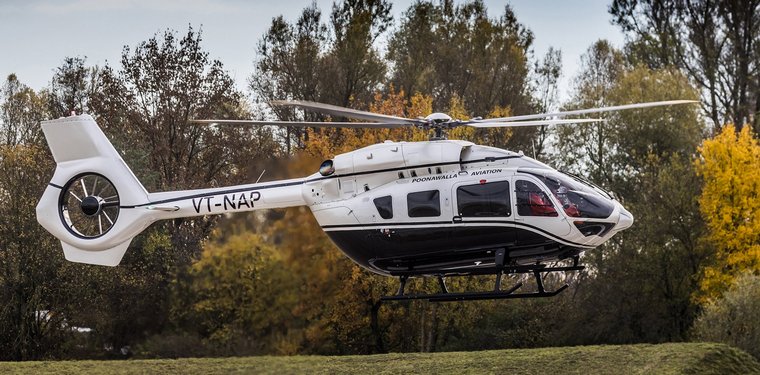 Airbus has delivered India's first fully customised, ACH145 helicopter to Mr Adar Poonawalla, CEO and Executive Director of Serum Institute of India, the world's largest vaccine manufacturer by doses. This marks the entry of the highly successful twin engine helicopter into India's private and business aviation market. The helicopter will be ready to fly in India by the end of January. Photo © Airbus. "Airbus is the market leader in civil helicopters in India. Our VIP customers come to Airbus Helicopters for unparalleled quality and a bespoke experience," said Anand E Stanley, President and Managing Director, Airbus India & South Asia. "They rely on our products' ability to combine state-of-the-art technology with new transportation possibilities." The helicopter provides a spacious cabin that can seat up to eight in ACH Line, ACH Mercedes Benz Style or ACH bespoke versions. The ACH145 features Airbus Helicopters' Helionix avionics, including a standard 4-axis digital Automatic Flight Control System for reduced pilot workload. Fenestron enclosed tail rotor dramatically reduces noise levels. The Turbomeca Arriel2E engines, with dual channel FADEC, generate 951 shaft horsepower for take-off and allow improved hover and one-engine inoperative performance as well as increased maximum gross weight capability. "The latest delivery proves once again that Airbus is the only Original Equipment Maker which is able to offer helicopters embedding the highest levels of innovation and end-to-end solutions for the ease of operations of customers. The delivery of this helicopter is an important milestone for us," said Ashish Saraf, Head, Airbus Helicopters India & South Asia.   Australia, Sydney: A National Jet Express British Aerospace BAe-146-300 took off from Sydney for a flight to Brisbane however; the rear tail stand had remained attached and separated during rotation for take-off. The tail stand came to a stop on the runway surface as foreign object debris. The aircraft landed safely at Brisbane. New Zeeland, North of Taupo: A Bell 206L-3 LongRanger III operated by T & P Williams Limited PO clipped high tension power Lines then crashed near Maroa Road at Atiamuri. The pilot, the lone occupant suffered only moderate injuries. The aircraft was damaged beyond repair. USA, Jackson County: A Bell 206L-3 LongRanger III operated by Erickson Inc on a routine training flight went missing shortly after taking off from Medford-Rogue Valley International Airport. The Wreckage was located about six hours later heavily wooded area near exit 6 off Interstate 5. The pilot was fatally injured. India, Uttar Pradesh: An Indian Air Force "Jaguar" fighter on a routine mission from Gorakhpur crashed in Kushinagar, Uttar Pradesh, in the north of India. The pilot manged to eject safely.   1 FEBRUARY 1920 The South African Air Force is established as an independent air arm. At the outbreak of World War I, the Union Defence Force had realised the urgent need for air support which brought about the establishment of the South African Aviation Corps (SAAC) on 29 January 1915. Aircraft were purchased from France (Henri Farman F-27) while the building of an airfield at Walvis Bay commenced in earnest in order to support operations against German forces in German South West Africa. By June 1915 the SAAC was deployed to its first operational airfield at Karibib in German South West Africa in support of Gen. Botha's South African ground forces. On 9 July 1915, the German forces capitulated and most of the pilots and aircraft of the SAAC were sent to Britain in support of the Imperial war effort 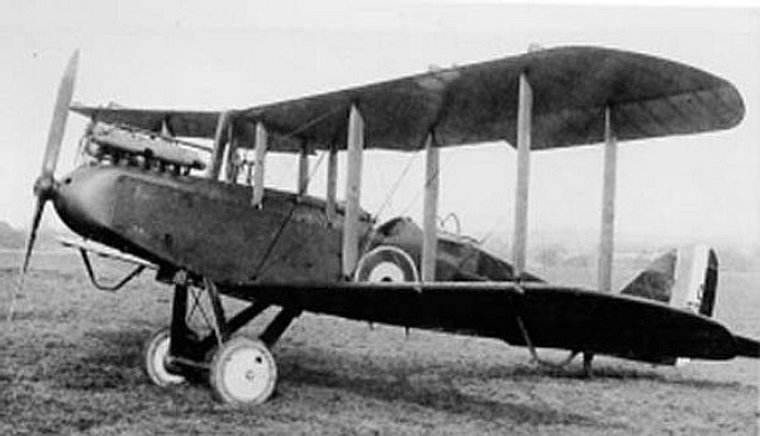 A Airco D.H.9 On conclusion of the First World War, the British Government donated surplus aircraft plus spares and sufficient equipment to provide the nucleus of a fledgling air force to each of its Dominions. As part of this donation, which was to become known as the Imperial Gift, South Africa received a total of 113 aircraft from both the British Government (100 aircraft) as well as from other sources (13 aircraft). On the 1 February 1920 Colonel Pierre van Ryneveld was appointed as the Director Air Service with the task of forming an air force, the date is used to mark the founding of the South African Air Force. In December 1920 the South African National insignia was added to aircraft for the first time. An Orange, Green, Red and Blue roundel was added to an Avro 504K for trial purposes but the colours were found to be unsuitable and were replaced with a Green, Red, Lemon, Yellow and Blue roundel in December 1921. These colours remained until 1927 when they were replaced with the Orange, White and Blue roundels. The first operational deployment of the newly formed Air Force was to quell internal dissent, when in 1922 a miner's strike on the Johannesburg gold mines turned violent and led to the declaration of martial law.  |
                       |
 |
 |

Copyright © Pilot's Post PTY Ltd
The information, views and opinions by the authors contributing to Pilot's Post are not necessarily those of the editor or other writers at Pilot's Post.